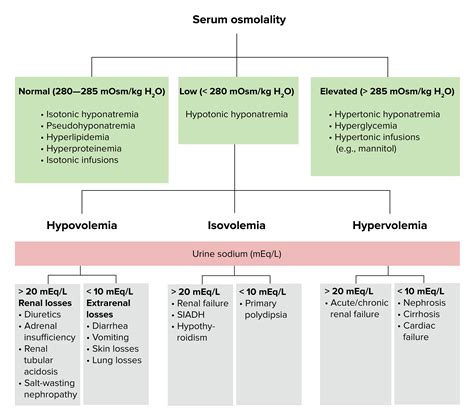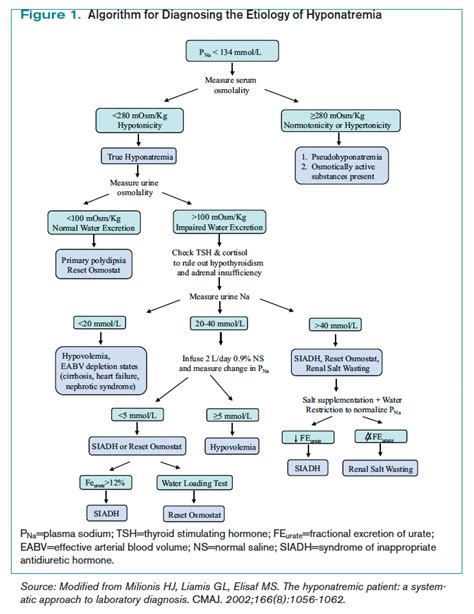Intro
Discover the causes and symptoms of SIADH, a hormonal disorder affecting fluid balance, and learn about its diagnosis, treatment, and management, including hyponatremia and hypersecretion of ADH.
The Syndrome of Inappropriate Antidiuretic Hormone Secretion, commonly referred to as SIADH, is a condition where the body produces an excessive amount of antidiuretic hormone (ADH), also known as vasopressin. This hormone plays a crucial role in regulating the amount of water in the body by controlling the amount of water reabsorbed by the kidneys. In SIADH, the excessive production of ADH leads to an inappropriate retention of water, resulting in hyponatremia, a condition characterized by low sodium levels in the blood.
SIADH can be caused by a variety of factors, including certain medications, lung diseases, brain disorders, and cancer. The condition is often seen in patients with small cell lung cancer, which can produce ectopic ADH, leading to SIADH. Other conditions, such as pneumonia, stroke, and head trauma, can also trigger the excessive production of ADH. The symptoms of SIADH can vary depending on the severity of the condition, but common symptoms include headache, nausea, vomiting, and seizures.
The diagnosis of SIADH is based on a combination of clinical presentation, laboratory tests, and imaging studies. Laboratory tests typically show hyponatremia, with a low serum sodium level, and an elevated urine sodium level. Imaging studies, such as computed tomography (CT) scans or magnetic resonance imaging (MRI), may be used to rule out other conditions that can cause hyponatremia. The treatment of SIADH depends on the underlying cause and the severity of the condition, but it often involves the use of medications that inhibit the action of ADH, such as vasopressin receptor antagonists.
Causes of SIADH

Medications that Can Cause SIADH
Some medications can cause SIADH by stimulating the release of ADH or increasing its action. These medications include: * SSRIs, such as fluoxetine and sertraline * Carbamazepine, an anticonvulsant medication * Cyclophosphamide, a chemotherapy medication * Chlorpropamide, an oral hypoglycemic medication * Vincristine, a chemotherapy medicationDiagnosis of SIADH

Laboratory Tests for SIADH
Laboratory tests are essential for the diagnosis of SIADH. These tests include: * Serum sodium level * Urine sodium level * Osmolality tests, such as serum osmolality and urine osmolality * ADH level * Thyroid function tests, such as thyroid-stimulating hormone (TSH) and free thyroxine (FT4) * Adrenal function tests, such as cortisol and aldosteroneTreatment of SIADH

Medications Used to Treat SIADH
Medications play a crucial role in the treatment of SIADH. These medications include: * Vasopressin receptor antagonists, such as tolvaptan and conivaptan * Loop diuretics, such as furosemide and bumetanide * Demeclocycline, an antibiotic that can increase urine output * Urea, which can increase urine output and reduce water retentionComplications of SIADH

Prevention of Complications
Prevention of complications is crucial in the management of SIADH. This can be achieved by: * Early recognition and treatment of SIADH * Close monitoring of serum sodium levels and urine output * Avoidance of medications that can exacerbate SIADH * Treatment of the underlying cause * Education of patients and families about the condition and its managementPrognosis of SIADH

Factors that Affect Prognosis
Several factors can affect the prognosis of SIADH, including: * Underlying cause, such as malignant tumors or lung diseases * Severity of hyponatremia * Presence of complications, such as seizures or coma * Response to treatment * Presence of other medical conditions, such as heart disease or liver diseaseWhat is the main cause of SIADH?
+The main cause of SIADH is the excessive production of antidiuretic hormone (ADH), which can be caused by various factors, including malignant tumors, lung diseases, brain disorders, and medications.
What are the symptoms of SIADH?
+The symptoms of SIADH can vary depending on the severity of the condition, but common symptoms include headache, nausea, vomiting, and seizures.
How is SIADH diagnosed?
+SIADH is diagnosed based on a combination of clinical presentation, laboratory tests, and imaging studies, including serum sodium level, urine sodium level, and osmolality tests.
We hope this article has provided you with a comprehensive understanding of SIADH, its causes, diagnosis, treatment, and complications. If you have any further questions or would like to share your experiences, please feel free to comment below. Additionally, if you know someone who may be affected by SIADH, please share this article with them to help raise awareness about this condition.
